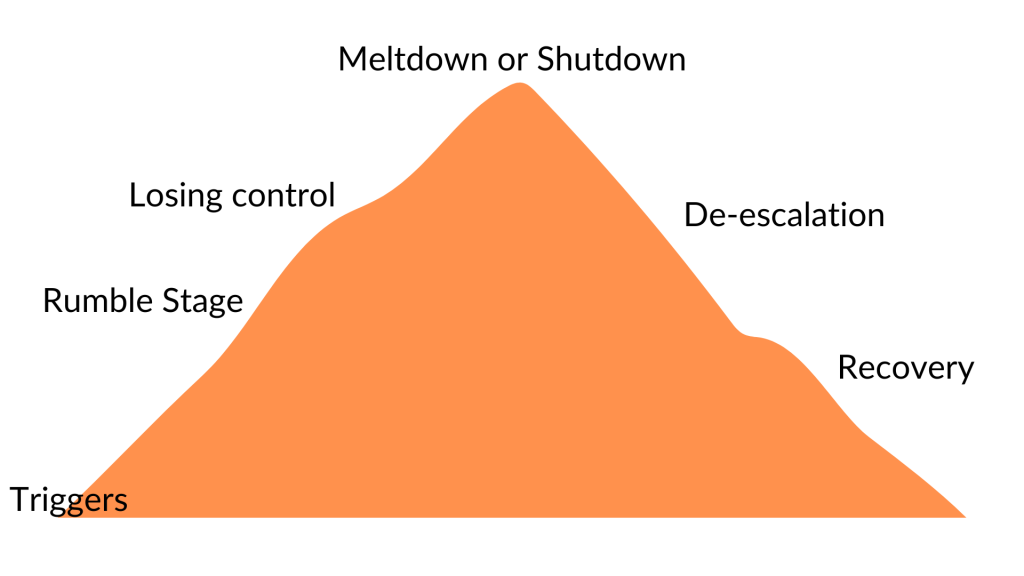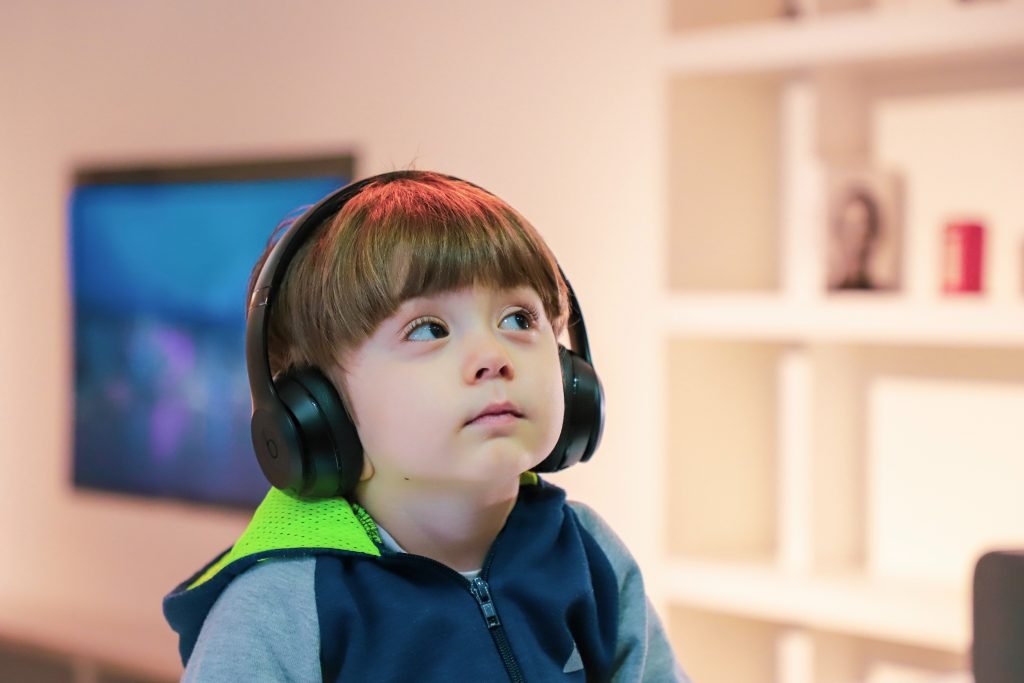How Understanding Autistic Meltdowns and Shutdowns Can Help You To Support Your Child (And Yourself)

Autistic meltdowns and shutdowns are an unavoidable part of the autistic experience. They are an autistic person’s body’s way of supporting them when their nervous system is overwhelmed. Meltdowns and shutdowns are a necessary release to help the autistic person’s nervous system return to homeostasis (regulation).
However, these essential survival mechanisms of having an autistic brain are still largely misunderstood and misinterpreted by society at large.
Many autistic children and teens are shamed and punished for their meltdowns and shutdowns. Parents of autistic children are often judged for their children’s meltdowns or shutdowns because the public perception is that they don’t know how to ‘discipline their children correctly’.
So what are autistic meltdowns and shutdowns and how can we support our children (and ourselves) when they occur?
Let’s start with what autistic meltdowns and shutdowns are not.
Would you like tools and strategies to support your child with meltdowns/shutdowns? Check out The Neurodivergent Family Toolbox
What Autistic Meltdowns And Shutdowns Are NOT:
- They are not intentional.
- They are not tantrums, panic attacks or ‘bad behaviour’.
- They are not only due to external factors/demands but can be triggered by internal factors/demands too.
- They are not your child trying to control or manipulate you.
- They are not personal.
- They are not a product of ‘bad parenting’.
- They are not something that needs to be punished or ‘trained’ out of your child.
- They are not something that can be controlled or often avoided.
According to Phung, Penner, Pirlot, & Welch, 2021
Meltdowns and shutdowns are an intense response to overwhelming circumstances, and occur when an autistic person’s brain, sensory and nervous systems become so stressed and heightened that they lose control of all of their reactions.
They are involuntary, and often consist of emotional, cognitive and physical components.
Although similar things can trigger a meltdown or a shutdown the way this is communicated externally to others is different.
During a meltdown/shutdown, the person’s nervous system goes into defence mode and perceives everything around them as a threat. The autistic person will either go into fight/flight (meltdown) or freeze (shutdown).

Meltdowns
Meltdowns are an uncontrollable outward ‘explosion’ of emotions in response to built-up stress and sensory overload. Autistic individuals may cry, scream, try to run away or even hurt themselves or others in order to regulate themselves.
Here are some of the ways autistics have described what experiencing a meltdown feels like:
- “Complete loss of control, unable to stop hitting things and crying, screaming, lots of pain.”
- “Sometimes it’s like my mind goes blank and I am a being of pure emotion.”
- “Being on fire but on the inside.”
- “To me, it feels like a complete loss of control so it’s really scary. It feels like the ground is disappearing and I’m falling endlessly. When I was a kid/teenager I used to hurt myself during a meltdown because it focuses the mind. It’s a relief because you can only think of the pain. (@autistic.qualia)
Shutdowns
Shutdowns are an uncontrollable inward ‘implosion’ of emotions in response to built-up stress and sensory overload.
Due to the internalised nature of shutdowns, they are a lot harder to identify and may be missed. This can make shutdowns potentially a lot more damaging to your child’s mental health as there is less chance for connection and support from a secure adult.
Autistic children may hide, curl up, go silent, or become situationally mute. They may dissociate, immerse themselves in a video game or start scrolling on their phone.
Why Are Meltdowns And Shutdowns So Challenging For Parents
There are many reasons why parents may find their children’s meltdowns/shutdowns challenging, here are a few:
Firstly, if you are autistic yourself the sound of your child’s crying or screaming can send you into sensory overwhelm. This may also trigger trauma because of how your meltdowns and shutdowns (or emotions in general) were responded to by your parents.
The things that your child says or does during a meltdown/shutdown can feel like a personal attack, especially if your child lashes out, hurts you or is verbally abusive. It can feel like you are walking on eggshells around your child or one mother expressed to me, “like being in an abusive relationship you can’t leave.”
We as parents generally have a very low tolerance for being present with our own emotions, let alone our child’s. Our child’s distress can fuel anxiety in us and all kinds of negative self-talk about us not being ‘good enough’ parents.
There is so much pressure out there to live up to societal perceptions of what ‘good parenting’ looks like. The ‘gold standard’ for ‘good parenting’ is often – quiet, compliant obedient children. When our children don’t fit this mold it can lead to feelings of perceived but also real judgment from others.
It is distressing when your child hurts themselves or others. Your child’s meltdowns/shutdowns can negatively affect other family members such as your other children or relationships with a co-parent (especially if you have different views on how these behaviours should be managed). Being the ‘person in the middle’ between your child and other family members alongside being the co-regulator for the child having the meltdown/shutdown can feel hard, confronting and exhausting.
What Is Important For Parents And Educators To Know About Meltdowns And Shutdowns?
The shame around experiencing meltdowns or shutdowns can have a direct impact on the mental health of our children especially when they are met with judgement and disbelief.
As parents, it is important that we not take our children’s meltdowns and shutdowns personally. We need to understand the function of meltdowns and shutdowns, including the neurobiology behind them and take a neuro-affirming, respectful and connection-based approach to support our autistic children through meltdowns/shutdowns.

When responding to our children’s meltdowns/shutdowns we need to look at both our child’s external environment and their internal signals of building stress, and remove whatever stresses and demands are possible.
This is further supported by the understanding that meltdowns/shutdowns often can’t be prevented and may be a necessary release and a function of our child’s neurobiology. It is essential that we know how to safely support our child (and ourselves) during a meltdown/shutdown and through the aftermath.
It is also important to note that an increase in meltdowns or shutdowns can be an indication of a decline in your child’s mental health or that they may be heading into burnout.
(Yellow Ladybugs, 2023)
Meltdowns And Shutdowns Are Part Of A Bigger Cycle
When seeking to understand meltdowns and shutdowns it is important to see them as part of a bigger cycle.

Triggers
First of all, there are the triggers. The triggers could be variable depending on the person and how their autism affects them. However, these triggers could vary from day to day.
Here are some of the things that can contribute to meltdowns/shutdowns:
Internal Tiggers
Your Child’s Neurobiology
Generally speaking, autistic brains experience the world in a much more intense way. Everything feels louder, brighter and more overwhelming. Autistic brains are more active at rest and are generally working harder and faster than neurotypical brains. This means that most autistic individuals have a much lower tolerance for stress and are more easily overstimulated.
Internal Systems And Health
Autistic children often have co-occurring conditions such as ADHD, poor interoception, alexithymia, PDA, OCD etc. This means that autistic children and teenagers may be triggered by conflicting internal signals, perceiving demands as a threat, repetitive thoughts or not being able to identify an emotion.
There is also a large co-occurrence with gastrointestinal conditions such as Crohn’s Disease, IBS or Celiac Disease. Autistic children often experience sleep disturbances which means that they may be experiencing sleep deprivation. There is a high co-occurrence with connective tissue disorders such as Ehlers-Danlos Syndrome which can cause chronic pain.
Menstrual Cycles
On top of periods taking a lot of executive function to manage, AFAB autistics may experience disturbances in their mental cycle such as severe PMS and other mood disorders leading up to their period, irregular periods, and extremely painful and heavy periods.
These internal triggers are often overlooked when we consider contributing factors to meltdowns/shutdowns.

External Triggers
There are many external triggers that can contribute to meltdowns/shutdowns some of these are:
- New environments.
- Changes to routine.
- Reality not meeting the autistic person’s expectation of how an event or situation will go.
- The amount of real or perceived demands in a person’s day.
- Social settings and the amount of masking needed to navigate them.
- Sensory overwhelm.
Would you like tools and strategies to understand your child’s triggers? Check out my Masterclass.
The Rumble Stage
The rumble stage is the period between the triggers and the meltdown/shutdown. The autistic person’s nervous system is activated and on alert. This stage can be extremely short or can have a longer window of time, depending on your child’s capacity and tolerance in the day.
It is important that as parents we are aware of our child’s ‘rumble stage’ as it is at this stage of the cycle that we have a higher likelihood of intervening. The way that we do this is through connection.
When connection is introduced at any point within this cycle, the chances of genuine de-escalation, which addresses the distressed child’s innate need for relationship-based safety, are far greater. By introducing meaningful connection and support, this distress cycle can be minimised.
Dr Alberto Veloso, psychiatrist
Meltdowns/Shutdown Stage
During the meltdown/shutdown stage, your main priority is safety. It is important that you keep your child safe and yourself calm and regulated.
Stay connected and present and ride it out.
De-Escalation and Recovery Stage
Meltdowns/shutdowns are moments of vulnerability for our children. Many children feel frightened by the lack of control that they have over their emotions, behaviours and bodies during these moments of overwhelm. Your child is likely to feel frightened that they will get into trouble or be rejected by you.

It is important that we communicate to our children that your love for them is not conditional on their behaviour. You don’t think that they are ‘bad’ or ‘broken’ or a ‘burden’ or ‘too much’.
That you are not afraid of their big emotions that it is safe to feel them and that they are safe and you are here for them.
Need Support? Book your FREE 30-minute call with me to chat about your child’s meltdowns/shutdowns and how to support them (and yourself).
Meet The Person Who Wrote This Blog

Tanya Valentin is an AuDHD person, mum of three, family coach, author and podcaster.
Tanya is an educator/coach with 25 years of experience working with children and families. She specialises in guiding parents of Autistic & ADHD children and teens through burnout recovery.
She is the founder of the Autistic Burnout Care and Recovery program for parents and the host of the Parenting Neurodivergent Kids Together podcast.
Tanya’s work combines education, emotional support, and practical strategies, reflecting her commitment to helping families create sustainable, connected relationships during difficult times.
Need support? Book a FREE 30-minute call with Tanya
